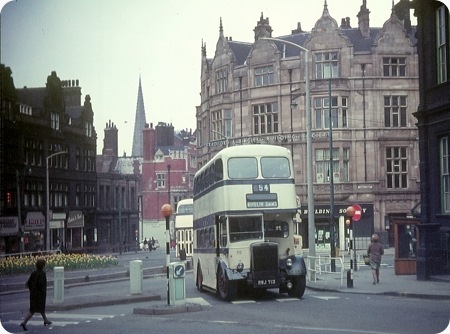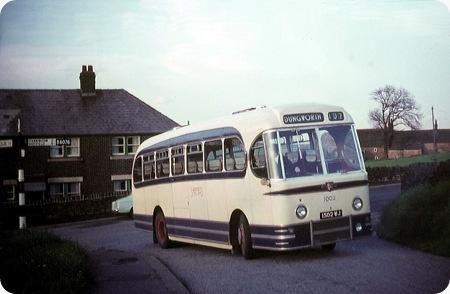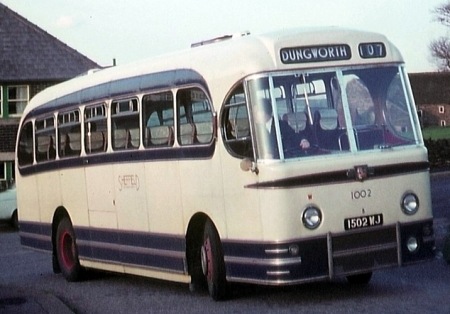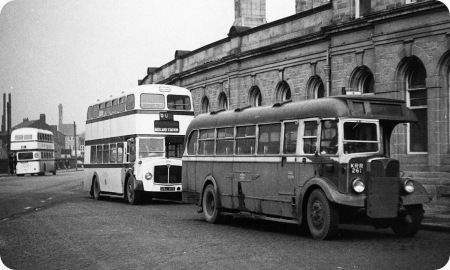Sheffield Corporation – Leyland Titan PD2 – RWJ 713 – 713
Sheffield Corporation
1954
Leyland Titan PD2/12
Weymann H32/26R
It’s 27th April 1968 and Sheffield 713 turns from Leopold Street terminus into West Street on another trip out into the country at Rivelin Dams.
713 was one of the batch of 56 (the largest single batch of buses purchased by Sheffield) delivered in March/April 1954 to replace trams on the Ecclesall – City – Middlewood route. Apart from accident victim 707, all the batch were withdrawn in 1967 and 1968 so 713 had only a short service life left by the time of this picture.
Nowadays Sheffield Supertram runs through the middle of this picture on its way to Middlewood but via a different route that 713 and its sister vehicles would have taken countless times during their 13/14 year life.
Photograph and Copy contributed by Ian Wild
A full list of Titan codes can be seen here.
———
13/09/11 – 07:53
April 1968 – my last few months in Sheffield as a student and I well remember these PD2s. Service 54 ran to a reservoir/control room just over the border in Derbyshire but was nevertheless a Corporation A route rather than a Joint Omnibus Committee B route, as was generally the case with cross-boundary services. The terminus was at the Norfolk Arms, now no more.
Geoff Kerr
———
13/09/11 – 17:00
Can anybody please enlighten me on the road layout at this point in 1968. On the face of it, there is a roundabout with yellow flowers but behind PD2 No. 713 is a rear engined machine seemingly turning right into Church Street ‘wrong way’. Also, there is a ‘No Entry’ sign at the Leopold Street corner.
John Darwent
———
14/09/11 – 07:43
Would that be The Norfolk Arms at Ringinglow Geoff ?
Roger Broughton
———
14/09/11 – 07:44
You’re not the only one who is intrigued, John. I was in the fourth form at school along the route of 713 when this was taken and cannot remember this odd layout – which is at the confluence of Leopold Street (to right), West Street (where 713 is entering), Church Street (where early Atlantean is heading) and Town Head Street (off to the left). The spire in the background is Sheffield Cathedral.
The Norfolk Arms was always well within the city limits. Even though they are different and wider now, there was always a great deal of countryside on the south and west side. In the post 1974 Sheffield, half the area is countryside, a third of it in the Peak District National Park.
David Oldfield
———
14/09/11 – 07:45
A one way loop had been introduced earlier in the 1960s comprising Leopold St, Church St and Fargate. Coming along Leopold St, traffic could turn left into West Street(as 713), right (wrong side of the roundabout)into Church St(as the Atlantean) or go straight ahead down Townhead St. Similarly traffic inbound on West St could use the roundabout in the conventional way and access Church St merging with the loop traffic from Leopold St. Sounds complicated written down but hope this assists.
Ian Wild
———
14/09/11 – 07:47
Nice buses these, but to me they always seemed slow and ponderous compared to the SWE-registered Regents with the same style of Weymann body, except for the outswept panels.
The AEC’s had that barking exhaust, and would come tearing out of the platforms in the bus station on their way to Hackenthorpe and Hemsworth, making Pond Street sound more like a racing car circuit than a municipal bus station. They had a smarter style of wheel nut ring as well, but I’d better not get going on that topic or there’ll be no end to it. What a splendid city for buses though, in those days.
Dave Careless
———
14/09/11 – 16:56
The Norfolk Arms mentioned above was on Manchester Road. The Norfolk Arms at Ringinglow is still very much in existence.
Stephen Bloomfield
———
14/09/11 – 16:56
What can I do, Dave, but agree with you. I had far more contact with the Regent IIIs than the PD2s – and did not regret it for one minute.
David Oldfield
———
15/09/11 – 09:27
Thank you for the explanation Ian. I worked in George Street from 1961 through 1964 but cannot for the life of me remember the one-way loop. Probably attentions towards the fairer sex had taken over at that time.
Ah well.
John Darwent
———
16/09/11 – 09:26
John, I think the one way loop came in later than 1964 which is why you wouldn’t recall it.
Ian Wild
———
17/09/11 – 08:04
Thanks Stephen, yes I know, we often call in when been out walking.
Roger Broughton
———
18/09/11 – 06:10
Photographs of this batch of buses always make me think of Endcliffe Park in Sheffield; you could see and hear them through the trees at the edge of the park, running along Rustlings Road every few minutes back and forth to Fulwood on the busy 88 service.
I remember going to the park on one of these one summer afternoon with my mother in the early sixties, and on getting off the bus, seeing for the first time in a toy shop window on Ecclesall Road an ‘Exide’ version of the Dinky Toys double decker. I pleaded for one, but it wasn’t in the equation, as despite whining and moaning all afternoon, it was apparent that an ice cream was as good as it was going to get! About four years ago, I finally bought one on eBay; it didn’t have a box, but it was considerably more than the modern day equivalent of 4/2 !!
Dave Careless
———
23/10/11 – 07:43
Hi very interesting site, much enjoyed. On this page, however, there is an error The Route 54 Rivelin Dams ran out of Pinfold Lane. The Route 51 Lodge Moor ran from Leopold Street. Route 51 was my first route as a rookie driver. The buses on that route during the 60s were AECs and on my first ever trip I was unable to get the handbrake off. I never experienced an AEC in driving school and was unaware that it was necessary to put ones foot down on the footbrake in order to release it. See this photo of mine of a PD2 I had driven to Rivelin Dams – //www.geograph.org.uk/
Dave Hitchborne
———
23/10/11 – 08:10
Sorry to argue, Dave, but the 51 and 50 left from Pinfold Lane – not far from Scout HQ and shop. I was a regular on the 51 from a young age, visiting family.
David Oldfield
———
04/12/11 – 07:46
Did the 54 later only go to Wyming Brook?
James Walker
———
15/03/12 – 09:30
Sorry, but I’m going to argue the point on this till the cows come home and my wife/clippie and I remember the Dore 50 and the Rivelin Dams 54 running from Pinfold Street and the Lodge Moor 51 ran from Leopold Street. Another reason for remembering the 51 running from Leopold Street is that it went from town via West Street and came back via Division Street and Barker’s Pool. On one occasion I was waiting to turn out of Barker’s Pool onto Leopold Street with a sports car in front when the driver of a Walkley 95 waived us both to proceed into Leopold Street. The sports car set off and I followed waiving and thanking the 95 driver when I suddenly realised that the sports car had stopped around the corner at the pedestrian crossing and I was inches away from it when I stamped on the brakes. The bus stopped, but my reserve conductor was hurled to the front of the bus where I heard him whack the bulkhead behind me. He then spent about 10 mins in Leopold Street instructing me on his knowledge of the English language. I believe his name was Abdul Roafe and I have a photo of him.
Dave Hitchborne
———
16/03/12 – 12:45
Regarding the debate on the 50, 51 and 54, I have had a look in the STD Timetable and the following is stated;
October 1951 T/T
50 Departs City (Trippett Lane) *
51 City (Pinfold Street)
54 and 55 City (Leopold Street)
May 1960 T/T
50 Departs City (Pinfold Street) *
51 City (Pinfold Street)
54 and 55 City (Leopold Street)
So, apart from the 50 moving a few yards to align with the 51 at Pinfold Street, they all remained more or less the same during this time scale. If there were subsequent alterations in the 1960’s, I can’t say as I don’t have the records but it seems that, at the moment, David O is ahead on points! Perhaps someone has a timetable to confirm departure points and routes taken in subsequent years.
John Darwent
———
17/03/12 – 06:22
Thank you for your defence, John. On reading Dave H’s post, something occurred to me. The 51 eventually became a cross city service to Gleadless/Herdings. At that point it would have travelled along Leopold Street from Gleadless to Lodge Moor. It would then go down Townhead Street and turn up broad Lane. In the other direction it left Broad Lane to end up going down Trippett Lane.
David Oldfield
———
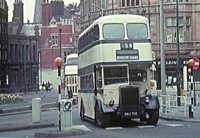 Vehicle reminder shot for this posting
Vehicle reminder shot for this posting
———
18/03/12 – 07:46
Regarding Sheffield Corporation buses in the 1950s does anybody remember a bizarre religious sect who took advertisement space with such warnings as ‘The Wages of Sin is Death’ and other warnings. Bringing the subject right up to date I notice that here at Lothian Buses we have a number of buses with the advertisement ‘Try Praying’.
Philip Carlton
———
19/03/12 – 09:18
Interesting observation Philip. Is the advertisement aimed at Edinburgh citizens in general, or just passengers waiting for buses provided by one of Lothian RT’s major competitors do you think?
Brendan Smith
Quick links to the - Comments Page - Contact Page - Home Page
